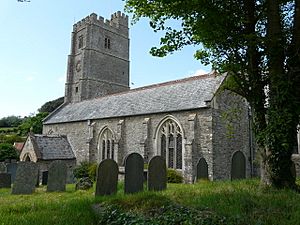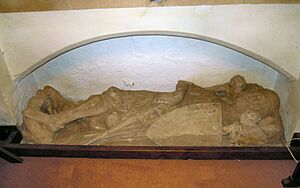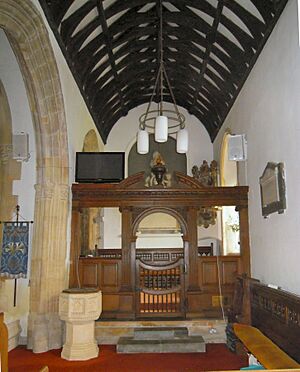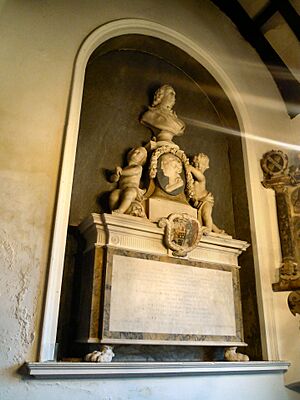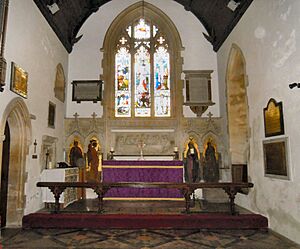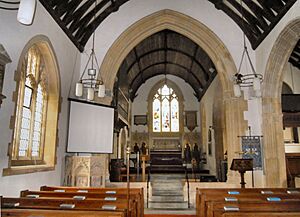St George's Church, Georgeham facts for kids
St George's Church is a very old and important church in the village of Georgeham, Devon. It's an Anglican church, which means it belongs to the Church of England. The church is named after Saint George, a famous saint. It was built a long, long time ago, in the 1200s! Because it's so special and historic, it's been protected as a Grade I listed building since 1965.
Contents
Church History: A Look Back in Time
The first time we find a record of a church in Georgeham was in 1231. A person named Robert de Edington was mentioned as the 'parson' (the priest) and 'patron' (someone who supported the church) of the area, which was then called Hamme. There might have been an even older church here, perhaps from Saxon or Norman times, but we don't have clear proof.
However, there are some very old items inside the church from the 1200s. These include a stone font (where baptisms happen) and a small carving of the Crucifixion from around 1300. This carving shows Christ and two figures, John and Mary, with angels crying at each end of the Cross. You can also see a piscina (a basin for washing sacred vessels) and a stone statue of a knight from about 1294.
Other old features include a small window with a four-leaf shape (called a quatrefoil) and another trefoil-shaped piscina. Both of these are from the 1300s. The church was first officially called St George's Church in 1356.
Building the Church: Stone by Stone
The church is built from rough stone, with larger blocks used for the tower. The edges and openings have carefully cut stone. The oldest part of the church is its tower, which was built in the 1300s. It has three levels, with strong supports and a top part with battlements, like a castle. There's also a small staircase tower with four narrow windows.
If you look closely at the outside of the tower, you can see signs that the main part of the church (called the nave) used to be taller than it is now. The main arches inside the church, which separate the nave from the side aisle, were most likely built in the 1400s.
Church Design: Changes Over the Years
The porch at the south entrance has a sundial with the date 1773. This might be when the porch itself was built. In 1762, the church had a big makeover, changing its inside look to a more classical style. Many of the windows were changed at this time. The wooden screen between the main part of the church (the nave) and the Pickwell Chapel also dates from this period. It has fancy columns and was repaired in 1912.
In 1767, new enclosed seating (called box pews) was added, along with raised galleries for important people to sit in.
Victorian Updates: A New Look
More changes happened in 1876, led by an architect named James Fowler. During this time, the old box pews were replaced with the pews you see today, and the raised gallery was removed. The vestry (a room for the clergy) was made bigger, and parts of the chancel (the area around the altar) were rebuilt.
The beautiful carving above the altar, showing the Last Supper, was added around this time. A new pulpit (where the sermon is given) made of special stone from Caen, France, was also installed. This pulpit has carvings of St John the Baptist, the Sermon on the Mount, and Saint Paul in Athens. The ceilings of the nave and south aisle are made of wood, shaped like a wagon, with carved decorations where the beams cross.
Special Memorials: Remembering People
The stone statue in the Pickwell Chapel is of Sir Mauger St Aubyn III. He was a knight who fought in Wales in 1283 and passed away in 1294. Local stories say he was a giant of a man, so strong that he could throw a huge stone into Georgeham from far away. They say two strong men half his age couldn't even lift it! His statue shows him as 6 feet tall, with his legs crossed, two dogs at his feet, a sword, and a shield. His wife, Isabel Pickwell, is also buried in the church, but her memorial is gone, probably moved during later renovations.
The Newcourt Family monument is the oldest wall memorial in the church, from 1645. It remembers Tobie Newcourt and shows him with his son William and William's four sons. The two female heads on the monument represent the wives of Tobie and his son.
The Harris Family monument is from 1776. Honour Harris put it up in the Pickwell Chapel for her parents, Dorothy and John Harris, and their three children who died when they were babies. When Honour Harris passed away, a small carving of her was added to the monument. There's also a memorial to the Chichester Family near the altar, remembering William Chichester, who was the church's Rector from 1750 to 1770, and his wife, Mary. It also mentions their daughter, Ann Chichester.
A large bible in the Pickwell Chapel is a special reminder of Archibald Cleveland. He was a soldier who took part in the famous Charge of the Light Brigade in October 1854. Sadly, he was killed a month later during the Battle of Inkerman. On the north wall of the nave, there's a memorial to Henry Tinker, a local from Croyde. He drowned in 1916 while trying to save a lady who was in trouble at Croyde Beach. The plaque shows the medal he received after his death for his bravery.
The Parish Map: A Community Project
On the south wall of the nave, you can see a beautiful fabric map of Georgeham Parish. It was revealed in 1995. Making this map took over 3,000 hours of stitching! About 85 artists and embroiderers from Georgeham and Croyde worked together on it. Even 70 children from Georgeham Primary School helped out. This project was started by the Women's Institute to celebrate their 75th anniversary in Devon. The map was even shown at The Barbican in London in 1996.
Other Features: Inside the Church
The church has many beautiful stained glass windows, mostly from the 1800s and 1900s. But there's one special window, a quatrefoil window on the north side, that's from the 1300s! It was found hidden during the Victorian renovations. It was then moved to the chancel and given new glass showing an angel holding a scroll that says "Sanctus Sanctus Sanctus" (which means "Holy Holy Holy").
Music and Time: The Organ and Bells
The church organ was installed in 1881. It was a gift to remember Frances, who passed away in 1880. She was the daughter of Reverend William Spurway and the wife of Reverend Francis Hole, who was the Rector from 1831 until his death in 1866. The organ was repaired in 1999, costing £10,000, and its hand pump was changed to an electric one.
The church tower has eight bells. Five of them were made in 1748, one in 1765, and the last two in 1926. The church clock was put in place in 1921 to remember the people from the village who died serving in World War I. The villagers paid for it. In 2014, for the 100th anniversary of World War I, the clock's face and hands were re-gilded (covered in gold leaf), and an electric winding system was added.
Art in the Church
On either side of the altar, there are murals (paintings on the wall) of Saints Francis and George, the Archangel, and the Virgin Mary. These were painted by an artist named Margaret Kemp-Welch, who lived in the village during the 1920s and 1930s.
Notable Burials: Famous People Here
Some interesting people are buried in the churchyard:
- Henry Williamson (1895–1977), who wrote the famous book Tarka the Otter.
- Negley Farson (1890–1960), an American author and adventurer.


